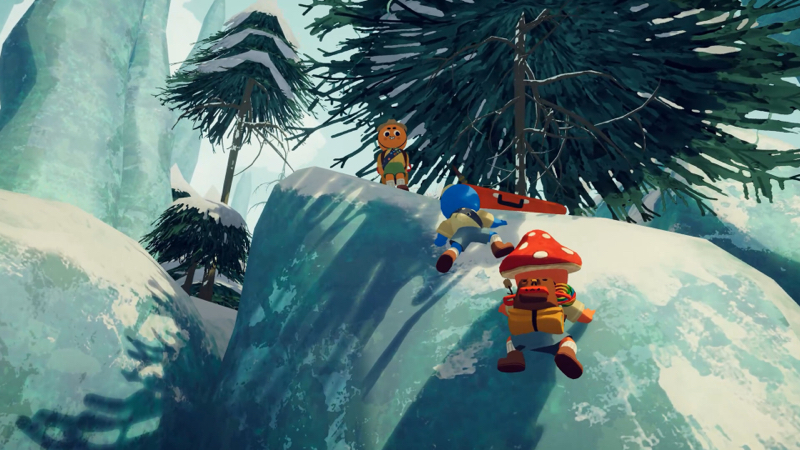
PEAK is the new viral hit developed by Landcrab (The name of the studio when Landfall and Aggrocrab work together). They are the same teams behind hits like Another Crab’s Treasure, Content Warning, Totally Accurate Battle Simulator and Haste).
They’ve managed to make another successful indie game hit that is currently going viral.
If you are new to PEAK then there are some things you need to know. Whether you’ve just survived your first storm or fallen off your first cliff, managing your stamina and gear can mean the difference between triumph and tragedy.
In this guide, we’ll break down everything you need to know to keep your energy up, pack smart, and work better with your team.
What Is Stamina in PEAK?

Stamina is the most important metric to manage in PEAK. Your stamina bar represents your character’s energy and endurance. It controls how far your character can climb, sprint, jump or carry weight before reaching exhaustion. Managing your stamina incorrectly can lead to hilarious but run-ending falls.
Stamina is drained by the actions you take and gear you carry. So it is essential that you plan your stamina expenditure carefully. It really is the core mechanic to manage in order to successfully reach the summit – be it in solo or co-op mode.
What Impacts Your Stamina in PEAK?

What Depletes Stamina?
Stamina is drained by almost every action you take:
- Climbing surfaces (especially icy or magma covered surfaces)
- Sprinting or jumping
- Carry heavy gear (especially uphill)
- Performing draining actions like pulling up teammates or lifting objects.
- Status Effects (more information below)
How To Recover Stamina?
The good news is that you can recover stamina in several ways:
- Find a flat or stable piece of ground to stop on.
- Set up a camp and rest at the provided checkpoints
- Drop some of your gear to reduce your load
- Acquire and use stamina boosting consumables
How Status Effects Limit Stamina
Certain negative status effects directly reduce your usable stamina by occupying a proportion of the stamina bar. These effects don’t just drain stamina — they shrink the maximum stamina available until they’re removed or wear off. Watch out for:
- Frost: Reduces max stamina unless you warm up
- Burn: Takes up stamina bar space, recover with medical aid
- Poison: Gradually limits stamina and may require antidotes
- Hunger: Lowers stamina regeneration until you eat
- Encumbrance: Occupies space due to excess weight
- Curse: Mysterious effects; always reduce stamina bar
- Sleepiness: Lowers stamina regen and max usable stamina
- Fall Damage: Temporary stamina reduction; worsens if untreated
Managing these effects is key. Even if your stamina bar looks half full, it might be mostly occupied by status effects, leaving you with only a sliver of energy for crucial climbs or escapes.
How To Choose The Right Gear Loadout

Know Your Role
The best gear to select depends on your role in the team. Dividing your climbing crew into distinct roles is the optimal climbing strategy.
- Carrier: Focus on large capacity backpacks and crates.
- Route Leader: Bring ropes, pitons, grapples and climbing gloves.
- Support: Carry medical kits, flares, stamina boosting items and back up ropes.
What Gear Hurts Stamina
Some items, which are often useful, but can can really hurt your stamina are:
- Crates and supply boxes.
- Unbalanced or overstuffed backpacks.
- Carrying to much as a solo climber – always divide the load.
Tips For Balancing Gear and Stamina

Tip 1: Leave Heavy Items Before Big Climbs
Offload crates at drop zones our ground markers before you embark on a big climb.
Tip 2: Keep An Eye On Your Encumbrance Indicator
Since your stamina bar depletes faster the more you carry, you’ll want to stay in the green or yellow zone for optimal stamina management.
It’s a good idea to keep an eye on this indictor whilst you climb. Many times I’ve forgotten to properly balance my carry weight and ended up running out of stamina unexpectedly.
Tip 3: Work Together!
- Let players who are carrying less scout out the best route.
- Don’t keep everything to yourself. Distribute items frequently.
- Use leapfrogging to get gear across terrain.
Tip 4: Plan Your Rests Strategically
You should plan to rest at designated rest zones that help break your climb up into manageable parts. Climbing too far, too fast is recipe for disaster. Make a base and recover your stamina.
Common Beginner Mistakes (and How To Fix)

- Overpacking: Don’t overpack. Only carry what your role requires. Bringing excessive gear slows everyone down and depletes your stamina.
- Forgetting To Rest: Just because you can keep going doesn’t mean it’s the best option. Plan rests and recover as a team.
- Ignoring Your Stamina Bar: Make sure to look at your stamina bar frequently to prevent unexpected falls.
- Solo Climbing: PEAK is built around team work, so make sure to take advantage of it.
Bonus Tips To Look Like A Pro
- Use replays to watch were things went wrong. This is a great tool to help improve your climbing skills. You can see exactly what you did wrong and how to better prepare for tomorrow’s seed.
- Keep playing to unlock custom gear that makes climbs easier and more comedic.
- Practice recovery routes in early maps – it’ll make a huge difference on harder peaks.
Now You Know How To Manage Stamina in PEAK
PEAK’s stamina system is an awesome mechanic that keep the game interesting and complex. Learning how to properly manage your stamina is the first step to becoming a pro player that can effortlessly reach any summit. Your teammates will also thank you for not being a stamina burden.
Enjoy tomorrow’s PEAK seed and happy climbing!